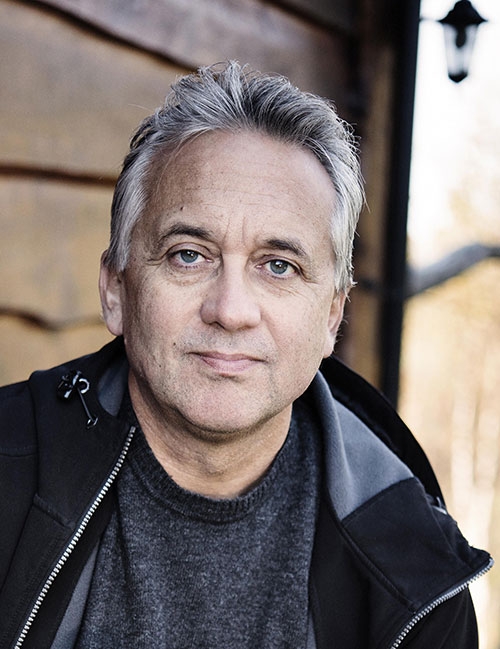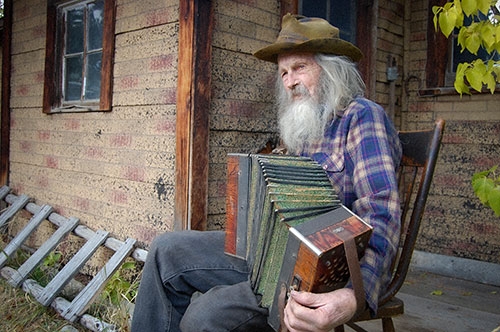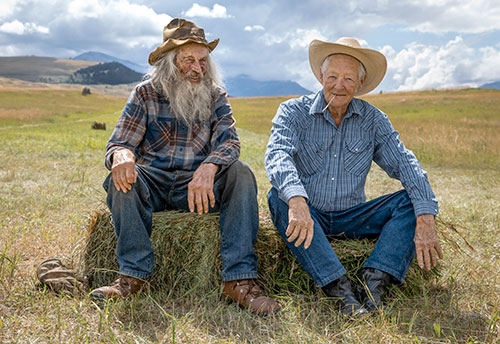You are here
Home ›A Conversation with filmmaker Frode Fimland, director of “John - The Last Cowboy” being screened in Waukon Sunday as part of Oneota Film Festival

Film director Frode Fimland ...

“John - The Last Cowboy” to be in Waukon ... John Hoiland, a rancher from Montana in his 90s, does not know a word of Norwegian, but he can extract several Norwegian 20th century songs from his father’s old accordion. The son of a Norwegian immigrant, Hoiland is the subject of a documentary film, “John - The Last Cowboy,” which is being screened at Town Theatre in Waukon this Sunday, February 19, beginning at 2:30 p.m., as part of the annual Oneota Film Festival. Image courtesy of FIMfilm.

Best friends for as long as they can remember ... John Hoiland and Jim Larkin have been best friends for as long as they can remember. Hoiland is the subject of a documentary film, “John - The Last Cowboy,” which is being screened at Town Theatre in Waukon this Sunday, February 19 as part of the annual Oneota Film Festival. Image courtesy of FIMfilm.
by Lynsey D. Moritz
From the day-to-day life of a Montana rancher, to the story of emigrating from Norway and holding onto those traditions, to generations of passionate and talented musicians, to a genuine and heartfelt lifelong friendship… Frode Fimland takes viewers on a journey of getting to know John Hoiland, the last cowboy, through the changing seasons in this beautiful country. This story is sure to resonate and move those who view it, and perhaps even make them reflect on their own life, too.
Ninety-two-year-old John Hoiland has run his huge ranch in Montana all by himself. The son of a Norwegian immigrant, he has been raised to work hard, be a steward of the land, and save his dollars for a rainy day. Through the years, people have offered him big money for his land. But life on the ranch is the only life he wants, and he finds great joy in the nature surrounding him, the freedom to work on his own land, and daily conversations with his best friend, Jim.
“John - The Last Cowboy” is a movie about Norwegian heritage, lifelong friendship, work ethic and dignity. It is a poetic tribute to the simple life, a peaceful escape from fast-paced modern society and a subtle reminder of what is lost. It also received great reviews when it premiered in Norway and was nominated for Amanda awards, the Norwegian equivalent to the Oscars.
“John - The Last Cowboy” will be screened at Town Theatre in Waukon this Sunday, February 19 as part of the Oneota Film Festival. The screening will take place at 2:30 p.m. and there is no admission charge. Film director Frode Fimland provided insight into the movie and his decision to pursue it as one of his creative works in the following Q&A series:
Q: When did you know you wanted to be a filmmaker/director? What was your inspiration?
A: I graduated from film and TV school in 1986 and until 2010 worked as a cameraman for TV companies and broadcasting companies. After that, I made films where I had the idea and was the director of the films. The inspiration is always to tell stories that can touch people and hopefully create some reflections.
Q: How did you meet John?
A: In 2016, I had the opportunity to follow a group of musicians from Norway who were on tour and were supposed to perform for Norwegian-Americans. They went through five states, from Minneapolis to Seattle. I knew then that I had the opportunity to meet many Americans with ancestors from Norway, and that a story could emerge that could be turned into a film. October 2, 2016, I met 89-year-old rancher John W. Hoiland for the first time, in Big Timber, MT. He was in the audience and brought his accordion with him to be able to play with the Norwegian musicians after the performance. This is where the film project started for me. I quickly saw that John had great potential, and I decided to make a film about the life of the rancher John, son of Emanuel from Norway, who came to the United States with the dream of a new and better life.
Q: Where did the overall concept of “John - The Last Cowboy” come from?
A: My goal with all the films I make is to strike something in the audience that makes them think about how we live our lives. I have experienced this with both Siblings films. I have received countless feedback from the audience about how the story of the siblings Magnar and Oddny has affected them. Some relate my stories to a time and a way of life that belong to the past, while others use them to question the materialistic and technological society in which we live.
I don’t want to moralize about the modern existence we live in, but I believe that it is important to be aware of the changes that are taking place, and to have a connection to both history, traditions and cultural heritage. This film will continue my documentation work, perhaps with an even greater perspective. In a time where protectionism and nationalism are on the rise, where refugees are no longer welcome, despite the fact that they are fleeing the utmost need, it is fundamentally important to remind ourselves that we have also sought a better life. Although Norwegians who went to the USA were not fleeing war, the situation was precarious for many with hunger and poverty.
I therefore feel that we as filmmakers have a special responsibility in the chaotic times we live in. Our responsibility is to draw the long lines and help the audience see the big picture, not just the hasty fragments of news that we are bombarded with through countless channels.
Q: Do you have a team that you regularly work with in making films?
A: I have had the same producer and the same editor in my last four films. Some of the others in the staff vary from film to film. In Montana, I had a very good collaboration with Jason Burlage, cinematographer in Bozeman. He was there when we needed two cameras, he flew the drone and he also did some recordings with John so I didn’t have to travel from Norway for a few recordings.
Q: What was the timeline for the making of this film? How often did you get to Montana?
A: I have had seven trips to Montana over a period of three years. In each shooting period, we filmed for four to five days and tried to plan so that we captured the different seasons with the beautiful nature that surrounds John’s ranch. The winter at 1,700 meters altitude can be hard for both people and animals in Montana, followed by spring when everything comes to life and gives hope for a good harvest. The hot summer and autumn with hunting and a new preparation for a hard winter. John has dealt with most things throughout his long life.
Q: How did John’s relationship with the camera, and with you, evolve over the time you worked with him?
A: With 90+ years, most of which have been spent outdoors in all kinds of weather, John’s face is as furrowed and hilly as the nature that surrounds him, an exciting starting point for ultra-close shots of him. With his sparkling eyes and sharp gaze, John can tell a lot without words - and we want to capture this. He is youthful despite his advanced age, and still works as if he were 60 years old, light on his feet and resilient. He has an extremely good memory and remembers not only stories, but also dates and years. Not least, he has warm humor and self-irony. We enter John’s life through work and toil; laborious chopping of wood, feeding the cattle through a cold winter, the weather reports from the television and domestic chores. He lives alone, but owns his own land and has the company of his two cats, his cows and calves.
Q: What were your favorite parts of shooting this film?
A: What was perhaps the most difficult part of the film and which became a more and more important part of the story, was the long friendship with Jim. For almost 70 years, they have been best friends and helped each other, and only on the very last day of filming did I get to film the two of them together again after Jim’s problem with his heart. Meeting with and the conversation between the two on the hay bales and at the grave gave me a good feeling and I knew I had made it. The best I could manage anyway.
Q: Did the filming experience go smoothly? Were there any issues along the way that you would be open to sharing?
A: There were actually no problems with the filming at all. John was on the offer side all the time, easy to work with and needed little to no instructions at all. He had his tasks for the week we were there, which I knew about in advance, and then of course we adapted it to the filming and how I could imagine filming the scenes.
Q: How did you hear about and get involved with The Oneota Film Festival?
A: Film festivals around the world are organized through FilmFreeway, where everyone must apply with their film to be accepted. I applied and luckily got in and I have also had contact with Vesterheim and Sons of Norway in my plans for screenings in the USA.
Q: What is John up to now?
A: I haven’t spoken to John since he was at the screening in Bozeman, last September, with an audience of almost 500 people. Then it was the next three years since we finished filming and we chose to postpone the premiere due to the pandemic. After that I have communicated with John’s neighbors and I know that now in January he has moved to an assisted living facility in Bozeman, but he is in good shape and will be 96 May 24.
ABOUT DIRECTOR FRODE FIMLAND
Director and cinematographer Frode Fimland had his directorial debut with the documentary “Siblings are Forever” in 2013. The feature documentary about two elderly siblings on a traditional farm on the west coast of Norway was a huge success in cinemas all over the country, and is the most successful documentary on Norwegian TV2 of all times. The film was awarded “The Feature Award” at Big Sky Film Festival in 2015. The same year, he directed the sequel “Siblings are Forever - the Grand Journey”, also an audience winner in Norwegian cinemas.
Fimland has previously worked on numerous wildlife and culture productions for the NRK (broadcasting company) both in Norway and all over the world. In 2018 he directed “The Wild Man of the North” for NRK. “John - The Last Cowboy” is his fourth feature film.

